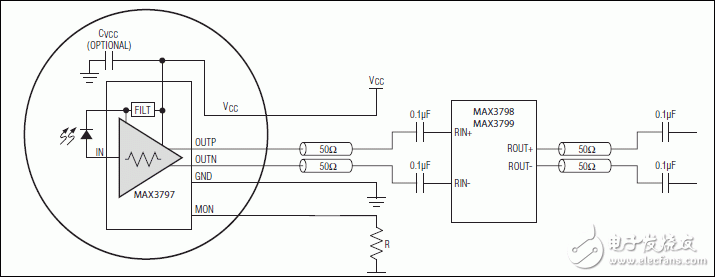The MAX3797 is a low-power transimpedance amplifier designed for optical transmission systems with data rates up to 10.3125Gbps and using PIN diodes.
The MAX3797 integrates an automatic gain control (AGC) architecture that provides a nominal small-signal transimpedance of 5.5kΩ. Input-referred noise is typically 1.25μARMS, which reflects a theoretical sensitivity of -14.8dBm OMA at a pin code (z = 0.55, re = 3) photodetector with a bit error rate (BER) of 10-12.
Make optical components using TO-46 or TO-56 packages with small chip size of 1mm x 0.76mm.
Key Features
Supply and temperature stable sensitivity
Up to 10.3125Gbps (NRZ) operation
Support capacitor-free ROSA
AGC gain is 5.5kΩ
3.3V single power supply
105mW power consumption
Wide-Bandwidth Current Monitor Enables RSSI-Based LOS Implementation
Die size 1mm x 0.76mm
chart

Typical Application Circuit
Previous article:MAX14954 Quad-Channel Equalizer/Redriver
Next article:MAX9240 25-bit GMSL deserializer
Recommended ReadingLatest update time:2024-11-17 02:34







- Popular Resources
- Popular amplifiers
-
 Operational Amplifier Practical Reference Handbook (Edited by Liu Changsheng, Zhao Mingying, Liu Xu, etc.)
Operational Amplifier Practical Reference Handbook (Edited by Liu Changsheng, Zhao Mingying, Liu Xu, etc.) -
 A Complete Illustrated Guide to Operational Amplifier Applications (Written by Wang Zhenhong)
A Complete Illustrated Guide to Operational Amplifier Applications (Written by Wang Zhenhong) -
 Design of isolated error amplifier chip for switching power supply_Zhang Rui
Design of isolated error amplifier chip for switching power supply_Zhang Rui -
 DAM medium wave transmitter high frequency power amplifier module test platform_Tian Tian
DAM medium wave transmitter high frequency power amplifier module test platform_Tian Tian
- High signal-to-noise ratio MEMS microphone drives artificial intelligence interaction
- Advantages of using a differential-to-single-ended RF amplifier in a transmit signal chain design
- ON Semiconductor CEO Appears at Munich Electronica Show and Launches Treo Platform
- ON Semiconductor Launches Industry-Leading Analog and Mixed-Signal Platform
- Analog Devices ADAQ7767-1 μModule DAQ Solution for Rapid Development of Precision Data Acquisition Systems Now Available at Mouser
- Domestic high-precision, high-speed ADC chips are on the rise
- Microcontrollers that combine Hi-Fi, intelligence and USB multi-channel features – ushering in a new era of digital audio
- Using capacitive PGA, Naxin Micro launches high-precision multi-channel 24/16-bit Δ-Σ ADC
- Fully Differential Amplifier Provides High Voltage, Low Noise Signals for Precision Data Acquisition Signal Chain
- Innolux's intelligent steer-by-wire solution makes cars smarter and safer
- 8051 MCU - Parity Check
- How to efficiently balance the sensitivity of tactile sensing interfaces
- What should I do if the servo motor shakes? What causes the servo motor to shake quickly?
- 【Brushless Motor】Analysis of three-phase BLDC motor and sharing of two popular development boards
- Midea Industrial Technology's subsidiaries Clou Electronics and Hekang New Energy jointly appeared at the Munich Battery Energy Storage Exhibition and Solar Energy Exhibition
- Guoxin Sichen | Application of ferroelectric memory PB85RS2MC in power battery management, with a capacity of 2M
- Analysis of common faults of frequency converter
- In a head-on competition with Qualcomm, what kind of cockpit products has Intel come up with?
- Dalian Rongke's all-vanadium liquid flow battery energy storage equipment industrialization project has entered the sprint stage before production
- Allegro MicroSystems Introduces Advanced Magnetic and Inductive Position Sensing Solutions at Electronica 2024
- Car key in the left hand, liveness detection radar in the right hand, UWB is imperative for cars!
- After a decade of rapid development, domestic CIS has entered the market
- Aegis Dagger Battery + Thor EM-i Super Hybrid, Geely New Energy has thrown out two "king bombs"
- A brief discussion on functional safety - fault, error, and failure
- In the smart car 2.0 cycle, these core industry chains are facing major opportunities!
- Rambus Launches Industry's First HBM 4 Controller IP: What Are the Technical Details Behind It?
- The United States and Japan are developing new batteries. CATL faces challenges? How should China's new energy battery industry respond?
- Murata launches high-precision 6-axis inertial sensor for automobiles
- Ford patents pre-charge alarm to help save costs and respond to emergencies
- The storage and downloading of time values sent by customers require sum verification or CRC verification
- EPWM CMPA register configuration problem
- Allegro's latest solution for 48v system
- EEWORLD University Hall----Live Replay: Microchip Security Series 12 - PolarFire? SoC FPGA Secure Boot
- "Praise my country": Let's gather together and talk about the useful domestic microcontrollers
- Ling Embedded Talent Recruitment is in full swing! Don’t run~ It’s you~
- A correct schematic does not necessarily produce a correct PCB design
- I hit a wall when I used EasyEDA for the first time
- [Repost] Understand the control principle and classification of switching power supplies in one article
- Kalman filter and UKF

 Operational Amplifier Practical Reference Handbook (Edited by Liu Changsheng, Zhao Mingying, Liu Xu, etc.)
Operational Amplifier Practical Reference Handbook (Edited by Liu Changsheng, Zhao Mingying, Liu Xu, etc.)
















 京公网安备 11010802033920号
京公网安备 11010802033920号